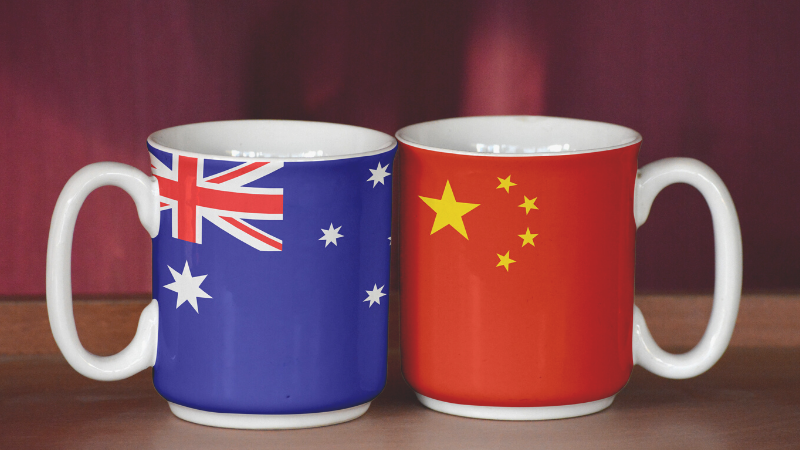Perspectives | Power shifts and China choices: Reflections on the Hugh White thesis 10 years on
September 08 2021

Perspectives is UTS:ACRI's commentary series, featuring a piece on a topical subject in the Australia-China relationship from an invited expert contributor.
Australian strategic analyst Hugh White’s 2010 Quarterly Essay, ‘Power Shift: Australia’s Future between Washington and Beijing’, argued that Australia faced a looming choice between what had been the supporting post-Cold War pillars of Australian security and prosperity: American primacy and the economic dynamism of the People’s Republic of China (PRC).
White argued that Australian strategic policy rested upon the twin assumptions that ‘China will just keep growing indefinitely, buying more and more from our miners at higher and higher prices’ and the US would ‘remain the strongest power in Asia, the region's natural leader and Australia’s ultimate protector’. This situation continued for most of the 1990s and 2000s, as Australia cashed in on PRC demand for the country’s natural resources and agricultural commodities and benefitted from the continuation of unchallenged American primacy, bolstering former Prime Minister John Howard’s stance that Australia would not have to choose between the two.
But latent tensions between what could be described as the ‘dual hierarchy’ of a US-led security order and a PRC-led economic order in Asia have become increasingly overt, presenting many states in the region with delicate balancing acts between their security relationships with Washington and their economic ties with Beijing.
For Australia, as I argue below, this overt competition has resulted not in a fundamental rethinking of our place in a more contested Asia. Rather it has become a path dependent ‘China Choice’ of doubling down our strategic wager that the US can maintain its primacy in the face of the PRC’s challenge.
Chimerica: Australia’s Magic Pudding?
Relying on US primacy to ensure Australia’s security, and on PRC economic growth to fuel Australian prosperity, arguably reached its peak under the government of John Howard (1996-2007). For Howard, American primacy was the necessary precondition for the ‘positive realism’ of Sino-Australian relations, whereby mutual interest and economic complementarity drove ties forward.
As White noted in 2010 and reiterated on August 25 2021 at the Australia-China Relations Institute, this approach was practical so long as the post-Cold War neoliberal consensus, which posited that continued economic globalisation and political liberalisation went together, continued. This also relied on the PRC itself calculating that it benefitted more than it risked from continued integration with the existing international order.
But what would happen, White wondered, if the PRC challenged American primacy – and thus undo Australia’s dual ‘security and prosperity’ wager?
According to White, the US would face three alternatives: retrenchment from Asia; acceptance of a power-sharing, ‘concert of Asia’-type arrangement; or outright competition with the PRC for primacy in Asia. Of these, the least-worst outcome for Australia, White argued, would be for Washington to accept and accommodate the PRC, because this would dampen prospects for war between major powers while protecting Asia’s economic dynamism.
The problem now, of course, is that the balance between the ‘dual hierarchy’ of American-led security order and a PRC-led economic order has been fundamentally altered by a range of factors related to the PRC’s own trajectory and the fate of American primacy.
First, the PRC has sought quite predictably to translate its economic weight into military power and strategic influence. These efforts, as White correctly notes, pre-date the ascent of Xi Jinping, belying some recent commentary ‘that the problem we have with China today is a reflection of Xi Jinping's personality or ambitions’. Rather, Xi’s ‘impatience’ to achieve the ambition of ‘China’s great national rejuvenation’ has brought into sharper relief the inherent tensions between the PRC’s desire for hegemony in East Asia and American determination to prevent that. Indeed, Beijing’s objective as Xi Jinping himself has stated, is to increase the PRC’s ‘comprehensive national power’ to ‘lay the foundation for a future where we will win the initiative and have the dominant position’.
Second, the cumulative effects of what we could term a 20 years’ crisis of American power, signposted by the disastrous invasion of Iraq in 2003, the 2008 Global Financial Crisis, the attempted retrenchment of the Obama years and Trump’s turn to a unilateralist ‘America First’ posture have not only taxed American resources, but also stimulated domestic debate about the prudence of maintaining American primacy.
While the rhetoric of the new administration of President Joe Biden may eschew the braggadocio of his immediate predecessor, its open embrace of ‘strategic competition’ as the operative framework for Sino-US relations suggests that it is also committed – in the words of the Trump administration’s 2018 US Strategic Framework for the Indo-Pacific – to maintaining ‘US strategic primacy in the Indo-Pacific region’.
Therefore the core problem for Australia now, as White argues, is that both Beijing and Washington’s mutual shift to overt ‘strategic competition’ upsets the relatively comfortable basis on which Australian security and prosperity has rested since the end of the Cold War. As the ‘relationship between the US and China has become much more starkly adversarial’, he argues, Australia’s choices ‘have become starker’ in turn.
White notes that Australia’s ‘fundamental problem’ here is that its preference ‘to preserve and perpetuate a US-led order in Asia’ is something which ‘China is deeply committed to overturning’. However, instead of directly confronting this reality, Australia has conducted policy on the basis of some wishful thinking that a US refocused on Asia after retrenchment from the Middle East and Afghanistan will defeat the PRC’s challenge and persuade it to accept American primacy.
The problems of choosing primacy
Despite the shifts of the past decade the continuity that most clearly links both White’s ‘Power Shift’ essay and his more recent reflections on it is the assertion that although Australia is clear about what it would like to see – i.e., the continuation of American primacy – it continues to dodge the question of ‘what to do if we don't get what we want’.
White suggests a number of factors that he thinks has contributed to the ‘default’ nature of this choice. Faced with ‘the uncertainty about America’s commitment to us’ Australia’s response ‘is to double down further’. This is due to the fact that policymakers ‘simply find it impossible to imagine that we might do anything else, because they simply cannot imagine an Australia that does not approach Asia on the basis of the support of a regionally dominant Anglo-Saxon, i.e., non-Asian, power’.
This, in part, suggests the continued salience of what former Director-General of the Australian Office of National Assessments Alan Gyngell termed Australia’s ‘fear of abandonment’ in Australian strategic policy, whereby Canberra will do its utmost to ensure the US not only remains engaged in Asia, but also demonstrate to Washington that it is a reliable ally. However, the balance between the two aspects of this dynamic has arguably shifted in favour of the latter. As University of Sydney academic David Brophy has noted, this has resulted in loud and performative declarations of ‘standing up’ to or ‘pushing back’ against China to advertise to the US that Australia is ‘getting tough’ with the PRC. If anything, then, White understates the actual ‘China Choice’ that has been made by Australia over the past three or four years. Rather than the binary choice between accepting a future Chinese or American-led order in Asia, the reality is that Australia has in fact already made its choice: to support the US in its endeavour to maintain primacy in Asia.
All of this – as White suggests – is entirely understandable given the clear benefits Australia has reaped from post-1945 American primacy. But this presents us with a clear problem: ‘doubling down’ on American primacy is no longer ‘practical politics’ given the PRC’s growing power and assertiveness and doubts about American commitment and staying power.
More broadly, however, a default choice to support American primacy maintenance would indicate that Australia cares more about power than order – ‘rules-based’, or otherwise – as Washington’s various responses to Beijing from Trump’s ‘trade war’ to Biden’s ‘Strategic Competition Act’ demonstrate that the US is ‘less concerned about upholding an order which could peacefully incorporate China as a superpower, and more preoccupied with reasserting its place as a regional hegemon’.
Australia’s default ‘China Choice’ circa 2021, then, emerges as a choice for a balance of power world. Balance of power systems, as White notes quoting Hedley Bull, are not systems ‘to avoid war’ but rather to ‘avoid hegemony, if necessary at the price of war’.
This conclusion poses two important questions: (i) have Australian policy-makers fully thought through the costs and risks of such a course of action; and (ii) have they communicated this clearly to the Australian public? While we may debate whether these particular questions have been adequately answered, we should nonetheless all agree that they should be answered. If nothing else Hugh White’s contribution to Australia’s strategic policy debate serves to remind us about the necessity for clarity not only about what our objectives are but also about what we can do if we cannot achieve those objectives.
Dr Michael Clarke is Senior Fellow at the Centre for Defence Research, Australian Defence College, and a Visiting Fellow at the Australia-China Relations Institute, University of Technology Sydney. He is the author of American Grand Strategy and National Security: The Dilemmas of Primacy and Decline from the Founders to Trump (Palgrave 2021).

